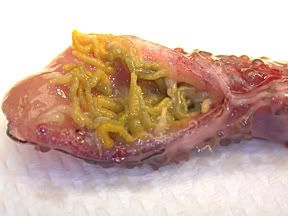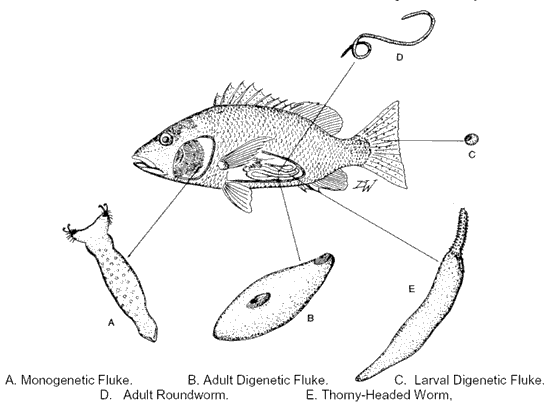florida joe
Well-Known Member
Not wanting to highjack a thread where the posts turned to the topic of worms I submit the following
Worms of Concern
Anchor Worm
Young anchor worms are free-swimming crustaceans that bury themselves into the fish’s skin. It takes several months before the worm becomes visible in form of holes or ulcers on the fish's body. After laying eggs, the worm dies off.
Since the worm cannot be removed by hand, a potassium permanganate bath for about 20 minutes should cure it (dosage 10ml/l).
Thorny Headed Worm
Visible symptoms are white or green threads on the gills. The fish often scratches on objects in the aquarium.
The thorny headed worm is similar to the anchor worm, only smaller in size. It attaches itself to the gills. The cure is also a potassium permanganate bath for 20 minutes (dosage 10ml/l).
Flukes
The symptoms are mucus-covered gills and/or body, red spots on the skin; fins appear eaten away, as well as rapid breathing.
Flukes are flatworms and are similar in appearance as Ick and can be better viewed with detail through a magnifying glass. Flukes will destroy the gills and kill the fish if left untreated.
The best cure is a potassium permanganate bath for 20 minutes (dosage 10ml/l).
Threadworms
Threadworms are internal fish that sometimes emerge from the fish's anus. This parasitic infestation can be fatal if not treated in time. Preferred treatment is parachlorometaxylenol soaked fish food and a bath in the same for several days (dosage 10ml/ liter).
Leeches
These external parasites are visible on the skin, gills and fins of the fish and are similar in appearance to Ick.
Since they attach themselves to the fish, the best method of removal is a bath in a salt solution for 20 minutes (dosage 2.5 % salt to water). During the bath, most of the leeches will simply fall off; the ones remaining can be removed with a pair of tweezers.
Worms of Concern
Anchor Worm
Young anchor worms are free-swimming crustaceans that bury themselves into the fish’s skin. It takes several months before the worm becomes visible in form of holes or ulcers on the fish's body. After laying eggs, the worm dies off.
Since the worm cannot be removed by hand, a potassium permanganate bath for about 20 minutes should cure it (dosage 10ml/l).
Thorny Headed Worm
Visible symptoms are white or green threads on the gills. The fish often scratches on objects in the aquarium.
The thorny headed worm is similar to the anchor worm, only smaller in size. It attaches itself to the gills. The cure is also a potassium permanganate bath for 20 minutes (dosage 10ml/l).
Flukes
The symptoms are mucus-covered gills and/or body, red spots on the skin; fins appear eaten away, as well as rapid breathing.
Flukes are flatworms and are similar in appearance as Ick and can be better viewed with detail through a magnifying glass. Flukes will destroy the gills and kill the fish if left untreated.
The best cure is a potassium permanganate bath for 20 minutes (dosage 10ml/l).
Threadworms
Threadworms are internal fish that sometimes emerge from the fish's anus. This parasitic infestation can be fatal if not treated in time. Preferred treatment is parachlorometaxylenol soaked fish food and a bath in the same for several days (dosage 10ml/ liter).
Leeches
These external parasites are visible on the skin, gills and fins of the fish and are similar in appearance to Ick.
Since they attach themselves to the fish, the best method of removal is a bath in a salt solution for 20 minutes (dosage 2.5 % salt to water). During the bath, most of the leeches will simply fall off; the ones remaining can be removed with a pair of tweezers.







